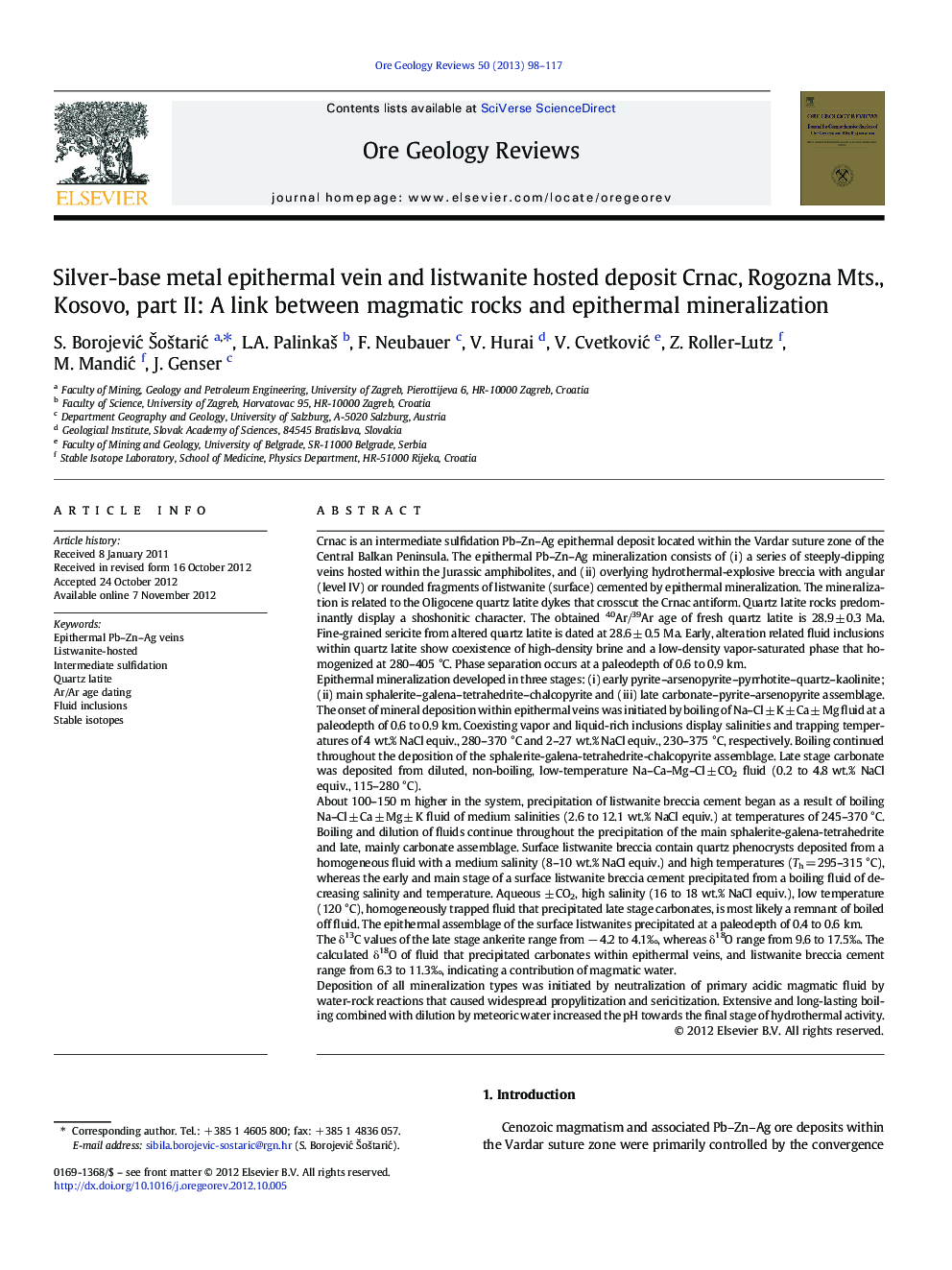| کد مقاله | کد نشریه | سال انتشار | مقاله انگلیسی | نسخه تمام متن |
|---|---|---|---|---|
| 4697582 | 1637253 | 2013 | 20 صفحه PDF | دانلود رایگان |

Crnac is an intermediate sulfidation Pb–Zn–Ag epithermal deposit located within the Vardar suture zone of the Central Balkan Peninsula. The epithermal Pb–Zn–Ag mineralization consists of (i) a series of steeply-dipping veins hosted within the Jurassic amphibolites, and (ii) overlying hydrothermal-explosive breccia with angular (level IV) or rounded fragments of listwanite (surface) cemented by epithermal mineralization. The mineralization is related to the Oligocene quartz latite dykes that crosscut the Crnac antiform. Quartz latite rocks predominantly display a shoshonitic character. The obtained 40Ar/39Ar age of fresh quartz latite is 28.9 ± 0.3 Ma. Fine-grained sericite from altered quartz latite is dated at 28.6 ± 0.5 Ma. Early, alteration related fluid inclusions within quartz latite show coexistence of high-density brine and a low-density vapor-saturated phase that homogenized at 280–405 °C. Phase separation occurs at a paleodepth of 0.6 to 0.9 km.Epithermal mineralization developed in three stages: (i) early pyrite–arsenopyrite–pyrrhotite–quartz–kaolinite; (ii) main sphalerite–galena–tetrahedrite–chalcopyrite and (iii) late carbonate–pyrite–arsenopyrite assemblage. The onset of mineral deposition within epithermal veins was initiated by boiling of Na–Cl ± K ± Ca ± Mg fluid at a paleodepth of 0.6 to 0.9 km. Coexisting vapor and liquid-rich inclusions display salinities and trapping temperatures of 4 wt.% NaCl equiv., 280–370 °C and 2–27 wt.% NaCl equiv., 230–375 °C, respectively. Boiling continued throughout the deposition of the sphalerite-galena-tetrahedrite-chalcopyrite assemblage. Late stage carbonate was deposited from diluted, non-boiling, low-temperature Na–Ca–Mg–Cl ± CO2 fluid (0.2 to 4.8 wt.% NaCl equiv., 115–280 °C).About 100–150 m higher in the system, precipitation of listwanite breccia cement began as a result of boiling Na–Cl ± Ca ± Mg ± K fluid of medium salinities (2.6 to 12.1 wt.% NaCl equiv.) at temperatures of 245–370 °C. Boiling and dilution of fluids continue throughout the precipitation of the main sphalerite-galena-tetrahedrite and late, mainly carbonate assemblage. Surface listwanite breccia contain quartz phenocrysts deposited from a homogeneous fluid with a medium salinity (8–10 wt.% NaCl equiv.) and high temperatures (Th = 295–315 °C), whereas the early and main stage of a surface listwanite breccia cement precipitated from a boiling fluid of decreasing salinity and temperature. Aqueous ± CO2, high salinity (16 to 18 wt.% NaCl equiv.), low temperature (120 °C), homogeneously trapped fluid that precipitated late stage carbonates, is most likely a remnant of boiled off fluid. The epithermal assemblage of the surface listwanites precipitated at a paleodepth of 0.4 to 0.6 km.The δ13C values of the late stage ankerite range from − 4.2 to 4.1‰, whereas δ18O range from 9.6 to 17.5‰. The calculated δ18O of fluid that precipitated carbonates within epithermal veins, and listwanite breccia cement range from 6.3 to 11.3‰, indicating a contribution of magmatic water.Deposition of all mineralization types was initiated by neutralization of primary acidic magmatic fluid by water-rock reactions that caused widespread propylitization and sericitization. Extensive and long-lasting boiling combined with dilution by meteoric water increased the pH towards the final stage of hydrothermal activity.
Journal: Ore Geology Reviews - Volume 50, February 2013, Pages 98–117